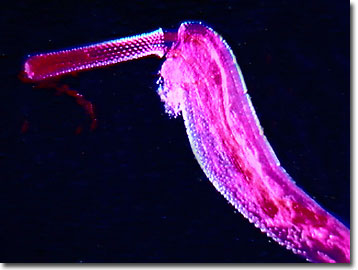Darkfield Digital Image Gallery
Acanthocephala (Spiny-Headed Worm)
Members of the phylum Acanthocephala are entirely endoparasitic, but when compared to other invertebrate parasites such as the roundworms (phylum Nematoda) and tapeworms (phylum Platyhelminthes, class Cestoda), they are relatively rare. However, acanthocephalans have succeeded by infiltrating niches within every vertebrate class.

View a high magnification image of the spiny-headed worm.
The spiny-headed worms received their common name in 1771, as a literal translation of the Greek roots for Acanthocephala (acantho = spiny, cephala = head), based on the characteristic eversible spiky proboscis at the anterior end. As an attachment organ, the spiny proboscis is outfitted with a hydraulic system for eversion, in the form of specialized fluid-filled glands, known as lemnisci, and spikes that function as anchoring hooks. To pull the proboscis back into an internal sheath, there are four associated retractor muscles. The proboscis also acts as the means of locomotion for these internal parasites. The bodies of the acanthocephalans are long, flattened, and vary in length from 1.5 millimeters to 1 meter, but do not include a digestive tract. Instead of a mouth, anus, and digestive tube, nutrients are taken in via pores and by diffusion, while the excretory system is tied to the sexual reproductive system. A thin cuticle of mucopolysaccharides and a noncellular cuticle cover the body walls of these endoparasites, protecting them from the digestive juices and immune systems of the hosts.
Economic impacts associated with spiny-headed worms result from severe discomfort and illness in parasitized domestic livestock. Instead of growing and reproducing in a profitable fashion, pigs and other farm animals expend energy trying to fend off the parasitic infection, feed less, and lose nutrients to the spiny-headed worms and damaged gut linings. Spiny-headed worms are dual-host parasites and there are three classes known. The members of the class Arachiacanthocephala are endoparasites typically found in the intestines of birds and mammals. The larvae of this parasitic class are found in terrestrial insects and the mature adults can reach lengths of 80 centimeters in their vertebrate hosts. Fish act as the main hosts for the adults of spiny-headed worms in the class Eocanthocephala, with crustaceans and aquatic insects acting as intermediate hosts. The most diverse of the acanthocephalans is the class Palaeacanthocephala, which parasitizes almost all vertebrate families, including humans.
Contributing Authors
Cynthia D. Kelly, Thomas J. Fellers and Michael W. Davidson - National High Magnetic Field Laboratory, 1800 East Paul Dirac Dr., The Florida State University, Tallahassee, Florida, 32310.
BACK TO THE DARKFIELD IMAGE GALLERY
BACK TO THE DIGITAL IMAGE GALLERIES
Questions or comments? Send us an email.
© 1995-2025 by Michael W. Davidson and The Florida State University. All Rights Reserved. No images, graphics, software, scripts, or applets may be reproduced or used in any manner without permission from the copyright holders. Use of this website means you agree to all of the Legal Terms and Conditions set forth by the owners.
This website is maintained by our
Graphics & Web Programming Team
in collaboration with Optical Microscopy at the
National High Magnetic Field Laboratory.
Last Modification Friday, Nov 13, 2015 at 01:19 PM
Access Count Since September 17, 2002: 29417
Visit the website of our partner in introductory microscopy education:
|
|
